Opened 15 June 1885 | ||
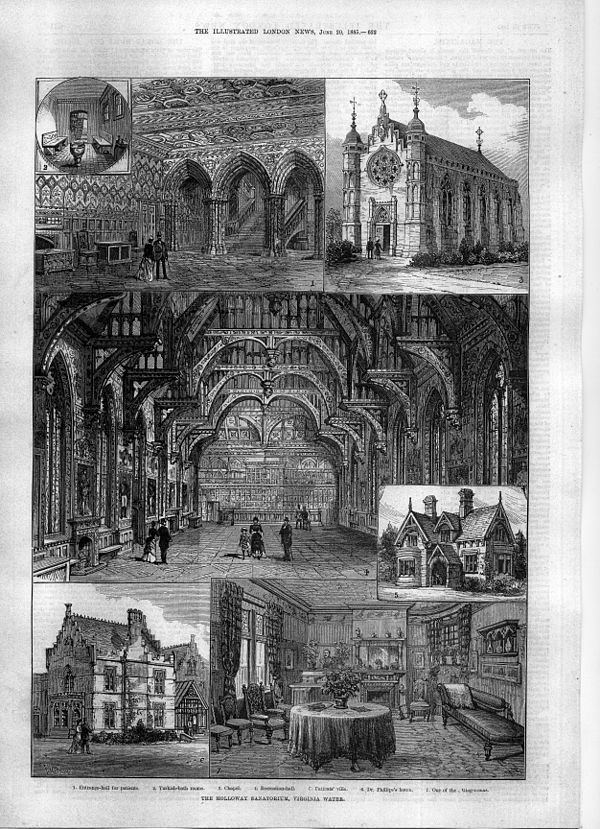 | ||
Similar Founder's Building, Christ Church - Ottershaw, Brookwood Hospital, Church of Our Lady of the Assu, Virginia Water Lake | ||
Holloway Sanatorium was an institution for the treatment of the insane on 22 acres (8.9 ha) of parkland near Virginia Water, Surrey, England within the boundary of Egham and today's contiguous London urban area, about 22 miles (35 km) south-west of Charing Cross.
Contents
- Royal holloway sanatorium damaged thames news
- History
- Thomas Holloways philanthropy
- Holloway initiates the design
- Competition for the plan
- Architect William Henry Crossland
- Site Virginia Water
- Building the Sanatorium
- Contemporary account
- Opening a contemporary account
- Staff and patients
- Wards
- Life in the sanatorium
- St Anns Hospital
- Lyne Place
- After World War II
- Development
- References

It was conceived by the wealthy philanthropist Thomas Holloway, designed in an elaborate Franco-Gothic style by W. H. Crossland, and built between 1873 and 1885. It is a stunning building, particularly when seen from the M25 with its sister building, the Royal Holloway College; Sir Nikolaus Pevsner regarded these two buildings as the "summit of High Victorian design". In 1948 it was transferred to the National Health Service. In the year 2000, after a period in which it had been neglected, it became a gated housing development and was renamed Virginia Park with many of the original features preserved under the direction of English Heritage.
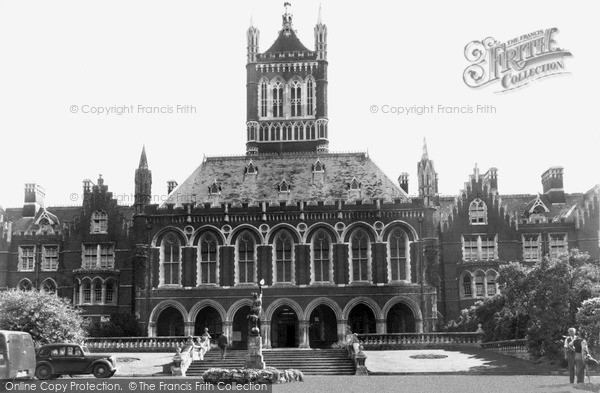
Royal holloway sanatorium damaged thames news
History

The site of Holloway Sanatorium is the present 'Virginia Park' development in Virginia Water, on the west side of Stroude Road and to the north of the railway station. It was one of two important symbols of the vision of the Victorian multi-millionaire entrepreneur and philanthropist, Thomas Holloway (1800–1883): the other being the nearby Royal Holloway College in Egham, Surrey (now Royal Holloway, University of London) which was opened two years later. Like the College, the Sanatorium was an extraordinary and extensive building, founded and personally funded by Holloway as a 'Gift to the Nation', and it was the fruit of the partnership between Holloway and his principal architect William Henry Crossland (1835–1908). The architecture was inspired by the gothic styles of the Cloth Hall of Ypres in Belgium with its conspicuous tower, and the Sainte-Chapelle in Paris.
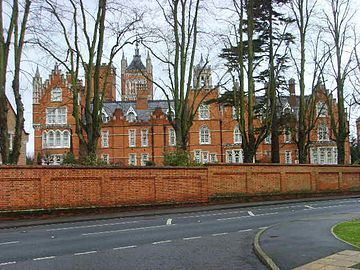
Work started on the building of the Sanatorium in 1873. The institution, 'a hospital for the insane of the middle class', was opened by the Prince and Princess of Wales (later King Edward VII and Queen Alexandra) on 15 June 1885. There were 73 certified patients admitted in the first year, and the number increased steadily so that in 1892 it already exceeded its capacity for 600 patients. A board of trustees managed the Sanatorium until it passed to the National Health Service in 1948. After becoming redundant to the NHS in 1981, it became derelict, vandalised and pillaged for the next 12 years. In 1994 the Sanatorium was re-developed, and to a great extent restored, to become in the year 2000 a gated residential estate.
Thomas Holloway’s philanthropy
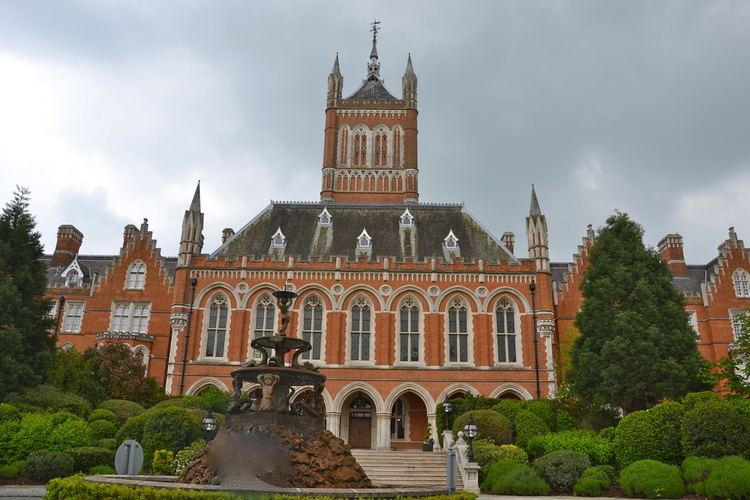
Thomas Holloway was a Victorian entrepreneur who made a fortune from the sale of his patent medicines, pills and ointments, designed to cure all ills. Where Holloway differed from other 'quack medicine' vendors was that he was one of the earliest entrepreneurs to appreciate the value of advertising: he spent huge amounts of money promoting his cures throughout the world and, as a result, reaped huge rewards.
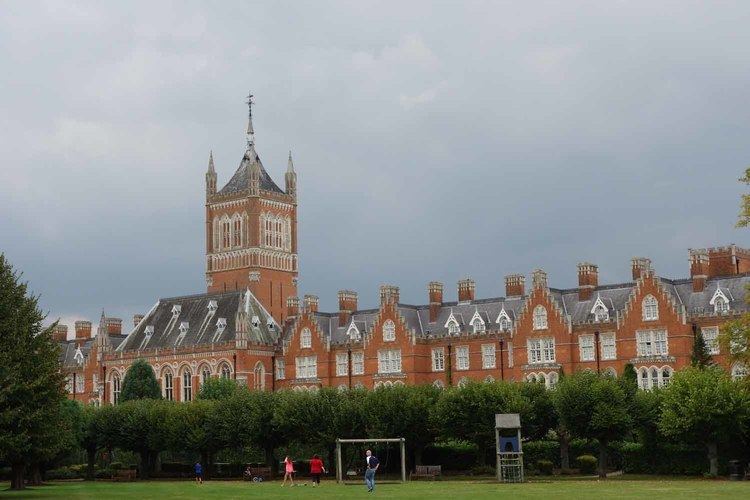
Looking for ways in which to spend his fortune, Holloway turned to philanthropy, and became a champion of progressive mental health care. George III's madness had excited public opinion about the correct and humane treatment for the insane. Therefore on 19 April 1861 Holloway attended a public meeting at the London Freemasons’ Hall in which Lord Shaftesbury, sincerely concerned with mental health, made a magnificent speech, crusading for funds for the foundation of an asylum for the middle-class insane. Lord Shaftesbury appealed for £5,000 and received immediately contributions totalling £760, though none from Holloway. But Holloway was impressed, and Shaftesbury must have been surprised to receive a letter from Holloway’s solicitor three years later announcing “a gentleman who is possessed of nearly a quarter of a million” and wished to see him with a view to disposing of that sum “for charitable uses”. The outcome was meeting between Holloway and Shaftesbury on 25 May 1864, when he resolved to spend out some of his fortune on the establishment of a Sanatorium for the mentally sick of the middle classes “the professional breadwinner whose income ceases when he is unable to work”. While pauper asylums gave refuge for the insane of the poorer classes, and care at private establishments could be bought by the rich, the middle classes neither deserved the former nor could afford the latter. Charity for the poor demeaned its recipients: as far as possible people should be assisted to help themselves. The proposed asylum was not intended for the permanently insane, but as a refuge in which the temporarily deranged should be assisted to resume their working lives. At that meeting Holloway told Shaftesbury that he intended to spend his fortune on a single building and in a single benefaction.
Holloway initiates the design
It was not until 1872 that Holloway had a meeting with the Commissioners in Lunacy, who entered warmly into his plans and promised every assistance to produce a model building. Whilst he seemed to have had some quite fixed feelings about architectural style he was no expert, and he was assisted by Professor Donaldson and T. H. Wyatt (who were architects for the Commissioners in Lunacy). Thomas Leverton Donaldson (1795–1885) was one of the foremost members of the architectural profession, the first Professor of Architecture at University College London, co-founder of the R.I.B.A., and its President in 1863-4. Thomas Henry Wyatt (1807–1880) was another distinguished architect, who had been President of the R.I.B.A. in 1870. Both Donaldson and Wyatt received some recompense for their services, the former 100 guineas and the latter 25 guineas. Holloway had a third adviser, George Godwin, the editor of The Builder. Holloway's initial idea was that the design of the building should be purely Italian, modelled on the river frontage of Somerset House. However, by October 1871 he had had a change of heart and wrote to Donaldson: “You will see that I have gone into the grand old Flemish style. I know that your taste is classical and which I greatly admire, but perhaps all things considered the Gothic would be most appropriate, as we can get red brick in the neighbourhood and a large building in the Italian style ought, I believe, to have stone facings”.
Competition for the plan
The Commissioners suggested that the best results would be obtained by submitting the plans to a competition of a limited number of architects. In September 1871 Holloway held the competition with the result that ten architects submitted eleven plans for the asylum. The architects who responded to the invitation to submit designs for the asylum were Crossland, Salomons & Jones; Alfred Smith; T. Roger Smith; Richard Phené Spiers; J. P. Seddon; J. S. Quilter; T. H. Watson; E. W. Godwin (two designs); F. & H. Francis and Thomas C. Hine. The winning entry, with a first premium award of £200, was by Crossland, Salomons and Jones. Alfred Smith was awarded the second premium of £100 and all the others received £50 for their trouble, except Hine, a Nottingham architect, who received only £25: possibly he had not actually been invited to submit a plan. The moneys were paid out in July 1872, and in August 1872 the plans were placed on exhibition in the Regent Street gallery of E. Freeman.
Architect: William Henry Crossland
William Henry Crossland later recalled that he had not wished to go into the competition on his own and had sought the assistance of the distinguished Irish architect John Philpot Jones. Edward Salomons practised in Manchester where he and Jones had designed the Reform Club in 1870. It is possible that the two had met in Rochdale in 1866 when Crossland was engaged on the Town Hall and Salomons on the town's theatre. Crossland planned it to look like the Cloth Hall at Ypres (having tried this design the previous year in the building of Rochdale Town Hall) and the Great Hall was designed in the style of the gothic La Sainte-Chapelle in Paris. Jones, who had most of the work on the asylum design, died soon after the foundation stone was laid and Crossland records that most of the work then fell to him, Salomons being in Manchester. Crossland received commission of £7,620 – without travelling expenses for himself or his staff.
Site: Virginia Water
In Victorian times many hospitals were built on spacious grounds in urban as well as rural locations, not only because more land was available, but also because space had therapeutic and practical value: "An asylum should be placed on elevated ground and should command cheerful prospects, should be surrounded with land sufficient to afford outdoor employment for males, and exercise for all patients, and to protect them from being overlooked or disturbed by strangers." This was the view of the Commissioners in Lunacy, quoted by an architecture researcher from York University, Robert Mayo, in a report for the Royal Institute of Chartered Surveyors.
A site was chosen, north of the town of Virginia Water, high on St. Ann’s Heath, part of his own land. Holloway wanted the Sanatorium to be visible from a railway: it certainly was, between Stroude Road and the straight northbound track from Virginia Water railway station. Work on the building began in the Spring of 1873, when a clerk of works was appointed. Holloway’s wife, Jane, laid the first brick. Crossland received his first commission payment of £300 on 2 March 1874. Once started, Holloway was determined that building should go forward apace. When his plan for the use of Portland stone in place of ornamental brickwork was not allowed to stand, Crossland had to set aside all his carefully planned working and detail drawings and hurriedly draw up alternatives as they were required by the masons.
Building the Sanatorium
The first clerk of works was J. P. Featherstone who had been a tenant farmer under Holloway: he was appointed in April 1873 and resigned on 24 December 1876. Among the contractors were: Sharpington & Cole, London (Masons); W. H. Lascelles, Finsbury (Joiner); George Burfoot, Windsor (Paving); Pontifex & Wood, London (Lead); Wilson W. Phipson (Heating); J. Gibson, Battersea (Landscaping); J. D. Richards, London (Furnishings). Ancillary works included the gas works at a cost of £1,950, six cottages and a workshop, and the sewage works which were constructed by John Thompson of Peterborough at a cost of £1,500.
There was a very large workforce on the site. The building accounts include costs of advertising for masons, not only locally in Surrey and Berkshire, but from as far as Birmingham and Manchester. Holloway worked supervising the project closely until prevented by illness: unfortunately he died on Boxing Day 1883, eighteen months before the Sanatorium was opened. By the time the institution was ready to admit patients, new regulations had come into force, and Crossland had to revise the internal arrangements to comply with the new safety regulations. Interior decoration was lavish: the great recreation hall with its magnificent beamed roof designed by Crossland was decorated by the Scottish architect and designer John Moyr Smith at a cost of £400.
Contemporary account
A contemporary account of the sanatorium is of interest. It is probable that much of the content came from Crossland and Holloway: the latter must have been pleased with the report for he subsequently sent a monetary gift to the author.
Opening - a contemporary account
The Sanatorium was officially opened by the Prince and Princess of Wales (later King Edward VII and Queen Alexandra) in 1885. The Prince brought a party of friends over from the Ascot Races for the ceremony.
Mr. Martin-Holloway, who delivered the opening address, was Thomas Holloway's brother-in-law George Martin (1833–1895), who had married Sarah Anne Driver the sister of Jane Holloway. George and his brother Henry assisted Thomas Holloway in the foundation of the Sanatorium and Royal Holloway College. After Thomas Holloway died George assumed the additional name of Holloway, and was knighted in 1887. Henry assumed the name Driver-Holloway.
The Illustrated London News reported:
...the building containing about 600 rooms, disposed on four floors, and capable of accommodating about 250 patients. The expense hitherto incurred is about £300,000.
The opening ceremony was in the large hall, which is to be used for concerts and other entertainments. The Royal party having taken their places on the platform, Mr. Martin-Holloway delivered a brief address, explaining that all the internal arrangements of the Sanatorium are planned for maintaining general health, for isolating special cases of disease, for enabling the attendants to live unobstrusively close to their patients, and for giving the patients an idea of freedom combined with active surveillance. The Prince of Wales briefly replied; and the guests dispersed to enjoy the hospitality of their host in dining-rooms and tents. The arrangements, which were in the charge of Mr. Trendell, were perfectly successful. The Sanatorium is ready for immediate occupation; and we believe that some patients were in the establishment this week. It is available only for curable cases of insanity; and the fees paid by patients will depend upon the amount of accommodation they require. Applications for half the possible number of admissions have been already accepted, and by the end of the year it is expected that the Sanatorium will be full.
Staff and patients
The first medical superintendent was Dr. Sutherland Rees Phillips.
In the early years of the sanatorium, nurses and domestic staff lived on the premises. There were 73 certified patients admitted in 1885, the first year. The 1891 census shows that Dr. Phillips was superintendent, listing 314 patients (including boarders) and 147 resident staff (medical, attendants and domestic). In 1901 the superintendent was Dr. William David Meares, and there were 384 patients and 210 resident staff . In 1911 the numbers were 368 inmates and 227 resident staff, with chief medical officer Dr. Thomas E. Harper and steward Jacob Jarvis Robertson. The censuses do not record non-resident staff.
Case Books were kept, with each patient being given a reference number. For the 40 years 1885-1924 there were 4902 female patients, and for a similar period there about the same number of male patients.
By 1929 the number of patients and staff had increased so much that a Nurses’ Home was built in nearby Sandy Lane at a cost of £22,000.
In 1934 the steward (administration manager) was Jacob Jarvis Robertson and his assistants Mr. Harrison and Philip Bishop; they were responsible for general management, provision of food and the keeping of household inventories.
In his acclaimed travel memoir Notes from a Small Island, author Bill Bryson writes affectionately about his time working at the Tuke Ward of Holloway Sanatorium as a young man in 1973. His met his future wife, a nurse in the Florence Nightingale Ward, while at Holloway.
Wards
The functions of wards and sections of wards changed according to administrative needs and the needs of patients treated, also influenced by the financial wealth of patients. For example, prior to nationalisation, Connolly ward, which was a small ward on the ground floor at the back of the hospital in 1972, had previously been incorporated with an equivalent floor space on the two floors above into a luxury suite for one patient only. The wards were named as below from the time the hospital was taken over by the NHS. Many of the less familiar names are of pioneering psychiatrists. Wards in other nearby hospitals, e.g. Brookwood Hospital in Woking, were similarly named.
The following names have been found for wards as of 1975. Wards are classified according to security required and further into Assessment, Rehabilitation and Elderly Care.
Assessment:
Security (now referred to as "P I C U", Psychiatric Intensive Care Unit) (Locked):
Rehabilitation:
Elderly Care Assessment:
Long term Elderly Care:
Day Hospital:
E.C.T. suite:
Unused:
From the late 1960s on the hospital followed the national trend toward "open door" policies. Physical security, locks, fences etc., were changed arbitrarily by "trial and error" rather than by consultative planning and reference to research. As in other psychiatric hospitals this proved difficult to implement safely, especially for elderly patients.
Life in the sanatorium
The sanatorium was run along the lines of an English country house at the turn of the century. There was elegant furniture in the rooms and corridors, the grounds were laid out for strolling, tennis, croquet and cricket; on summer afternoons a band would play for the entertainment of staff, patients and visitors; and there were concert parties in the evenings.
In 1903 lightning struck the roof, causing a small fire and £1,500 worth of damage.
Holloway Sanatorium was ahead in some of the new developments in the mental health field, such as the use of occupational therapy for recovering patients. It was also one of the first hospitals to include photographs of patients with their case notes.
Seizures were common with patients and treatment was often in the form of sleep-inducing bromides and chloral.
Strychnine, a stimulant, was also administered where thought effective. In the case of Reverend Dennis Moore, he left the asylum “highly benefitted by the social evenings and the agreeable companions he associated with (both ladies and gentlemen) during his months stay”.
The majority of patients spent their day engaged in leisurely activities such knitting, especially amongst female patients. Caroline Newman, a former teacher of music, is described as amusing herself “making ludicrous rag dolls”. By contrast, a male patient is noted as “never occupying himself in any way“.
St. Ann's Hospital
The Sanatorium expanded in time by buying other properties. In 1891 Hove Villa, Brighton was purchased by the Governors as a home where patients could benefit from the fresh seaside air. In 1909 the Scottish architect Robert Weir Schultz (1860–1951) was asked to design a permanent seaside home for the Sanatorium, and so in 1910 St Ann's Hospital at Haven Road, Canford Cliffs, Poole in Dorset, was built and replaced Hove Villa. Named after St. Ann's Heath, the site where Holloway Sanatorium was built, it was opened in 1912, on 14 acres (57,000 m2) of land, with a porter's lodge and later cottages for the chauffeurs. In 1948 Holloway Sanatorium and St. Ann's, both then psychiatric hospitals, formed a group of the South West Metropolitan Region of the National Health Service, but in 1960 the hospitals finally dissociated into different administrative groups.
St. Ann's Hospital is a Grade II listed building.
Lyne Place
Lyne Place, an imposing Regency house with gardens, is located two miles (3 km) south of Virginia Water at Wentworth Park. Lyne Place had been the home of the Russian philosopher P. D. Ouspensky between 1930 and his death in 1947. It was acquired by the Sanatorium and originally intended to be used for members of staff but was adapted for patients' accommodation in 1950. It has now been developed into luxury apartments.
After World War II
The management of the Sanatorium passed to the National Health Service on 5 July 1948, and it continued as a hospital with a catchment area including Weybridge, Walton, Chertsey, Egham and Virginia Water. To maintain revenue for an interim period until 1974 private patients continued to be admitted into a limited number of "amenity beds", paying for the relatively aesthetic surroundings, but receiving standard NHS treatment. In 1968 it became administratively part of the nearby Ashford Hospital, Ashford, Middlesex.
The travel writer Bill Bryson recorded that the Sanatorium had a charm about it because “it was full of wandering lunatics”. Bryson worked at the sanatorium in 1973 as a janitor on Tuke Ward. In his book, Notes From A Small Island, he describes the ward as home to “long-stay male patients in a state of arrested insanity”. According to Bryson, the place was one of the most extraordinary communities in England. The patients were allowed to wander freely down to the shops and back, mingling on equal terms with the locals, who affectionately referred to the institution as “the sanny”.
On 8 February 1978 a disastrous fire broke out on the stage of the cinema. The fire spread rapidly, fanned by a strong easterly wind. The patients were calmly escorted from the building and there was only one minor injury. The cinema and three wards, 'Clouston', 'Jane Holloway' and 'Thomas Holloway', were completely gutted and the electro-convulsive therapy department and sewing rooms were badly damaged.
The Sanatorium was closed in December 1980 and the remaining patients transferred to Ashford Hospital, Ashford, Middlesex, which became a psycho-geriatric unit (Holloway Unit). On 21 July 1981 there was a sale of "contents of Holloway Sanatorium: antique and period furniture" at Wentworth Auction Galleries. The site was sold by the NHS to a property company which planned to convert it to 120,000 sq ft (11,000 m2) of offices. After the buildings had passed through three owners and two public enquiries, ending up in the hands of a receiver, they remained empty and vandalised for 12 years, becoming completely derelict. Thieves stripped lead from the gutters, resulting in water damage. Development on the cricket pitch at the front of the main block and the demolition of the Medical Superintendent’s House were controversially allowed in the early 1990s, facilitating a rapid start on a restoration and development project by Octagon.
The main building was used in several early episodes of Inspector Morse, including the very first episode, The Dead of Jericho. Inspector Morse is seen on the main staircase, and the Dining Hall is used in the opening scenes. The facility was also utilized as a location for several music videos in the early 1980s, for artists including Bucks Fizz, Ozzy Osbourne, Adam Ant, The Cure, Bonnie Tyler and Alphaville. The 1986 slasher film Slaughter High was also filmed there. The Main Hall (Recreation Hall) was used in the Michael Caine TV Movie/Mini Series Jack the Ripper (1988 TV series) when Chief Inspector Frederick Abberline questions the beggars.
Development
In the early 1990s, Royal Holloway College looked seriously into the possibility of converting the Sanatorium into a major new hall of residence. The plans would have given the College two of England's greatest Victorian buildings, but building regulations made this too costly.
In 1994, under the guidance of English Heritage, a scheme by Octagon Developments to salvage this Grade I architectural wonder for the nation was accepted. Octagon spent six years in a punctilious art restoration and conversion project. Craftspeople in various disciplines returned the buildings to very near to the original. The Grand Hall was restored and the main building converted into 23 three- and four-storey town houses. The site became “Virginia Park”, a gated and walled development including 190 new houses and apartments, a spa complex, gymnasium, multi-purpose sports hall and an all-weather tennis court. It was described by English Heritage as one of the largest art-conservation projects in Europe. The entrance hall, now fully restored, is a riot of brilliant colours, patterns and grotesque imaginary creatures, and the Dining Room is now a recreation hall housing a swimming pool beneath its hammerbeam roof.
The former chapel building is separately listed as a Grade II* building.
